Pure and Yb-Doped LaxYySc4-x-y(BO3)4 Crystals: A Review of Recent Advances
Abstract
:1. Introduction
2. Huntite-Type LaxYySc4-x-y(BO3)4 Crystal
2.1. Material Synthesis and Czochralski Growth
2.2. Structural and Compositional Characterization
2.3. Optical and Vibrational Characterization
2.4. NLO Properties
3. Yb-Doped LaxYyS4-x-y(BO3)4 Crystal
3.1. Material Synthesis and Czochralski Growth
3.2. Evaluation of NLO Properties
3.3. Spectroscopic Properties
3.4. Laser Performances
4. Conclusions
Author Contributions
Funding
Data Availability Statement
Acknowledgments
Conflicts of Interest
References
- Mills, A.D. Crystallographic Data for New Rare Earth Borate Compounds, RX3(BO3)4. Inorg. Chem. 1962, 1, 960–961. [Google Scholar] [CrossRef]
- Chen, C.; Wu, Y.; Li, R. The Anionic Group-Theory of the Non-Linear Optical Effect and its Applications in the Development of New High-Quality NLO Crystals in the Borate Series. Int. Rev. Phys. Chem. 1989, 8, 65–91. [Google Scholar] [CrossRef]
- Leonyuk, N.I.; Leonyuk, L.I. Growth and characterization of RM3(BO3)4 crystals. Prog. Cryst. Growth Charact. 1995, 31, 179–278. [Google Scholar] [CrossRef]
- Tran, T.T.; Yu, H.; Rondinelli, J.M.; Poeppelmeier, K.R.; Halasyamani, P.S. Deep ultraviolet nonlinear optical materials. Chem. Mater. 2016, 28, 5238–5258. [Google Scholar] [CrossRef]
- Durmanov, S.T.; Kuzmin, O.V.; Kuzmicheva, G.M.; Kutovoi, S.A.; Martynov, A.A.; Nesynov, E.K.; Panyutin, V.L.; Rudnitsky, Y.P.; Smirnov, G.V.; Hait, V.L.; et al. Binary rare-earth scandium borates for diode-pumped lasers. Opt. Mater. 2001, 18, 243–284. [Google Scholar] [CrossRef]
- Li, Y.; Aka, G.; Kahn-Harari, A.; Vivien, D. Phase transition, growth, and optical properties of NdxLa1-xSc3(BO3)4 crystals. J. Mater. Res. 2001, 16, 38–44. [Google Scholar] [CrossRef]
- Ye, N.; Stone-Sundberg, J.; Hruschka, M.; Aka, G.; Kong, W.; Keszler, D. Nonlinear optical crystal YxLayScz(BO3)4 (x + y + z = 4). Chem. Mater. 2005, 17, 2687–2692. [Google Scholar] [CrossRef]
- Ye, N.; Zhang, Y.; Chen, W.; Keszler, D.; Aka, G. Growth of nonlinear optical crystal Y0.57La0.72Sc2.71(BO3)4. J. Cryst. Growth 2006, 292, 464–467. [Google Scholar] [CrossRef]
- Li, W.; Huang, L.; Zhang, G.; Ye, N. Growth and characterization of nonlinear optical crystal Lu0.66La0.95SC2.39(BO3)4. J. Cryst. Growth 2007, 307, 405–409. [Google Scholar] [CrossRef]
- Xu, X.; Ye, N. GdxLa1-xSc3(BO3)4: A new nonlinear optical crystal. J. Cryst. Growth 2011, 324, 304–308. [Google Scholar] [CrossRef]
- Xu, X.; Wang, S.; Ye, N. A new nonlinear optical crystal BixLayScz(BO3)4 (x + y + z = 4). J. Alloys Compd. 2009, 481, 664–667. [Google Scholar] [CrossRef]
- Gheorghe, L.; Khaled, F.; Achim, A.; Voicu, F.; Loiseau, P.; Aka, G. Czochralski Growth and Characterization of Incongruent Melting LaxGdyScz(BO3)4 (x+ y+ z = 4) Nonlinear Optical Crystal. Cryst. Growth Des. 2016, 16, 3473–3479. [Google Scholar] [CrossRef]
- Gheorghe, L.; Greculeasa, M.; Broasca, A.; Voicu, F.; Stanciu, G.; Belikov, K.N.; Bryleva, E.Y.; Gaiduk, O. Incongruent Melting LaxYySc4-x-y(BO3)4: LYSB Nonlinear Optical Crystal Grown by the Czochralski Method. ACS Appl. Mater. Interfaces 2019, 11, 20987–20994. [Google Scholar] [CrossRef]
- Shannon, R. Revised Effective Ionic-Radii and Systematic Studies of Interatomic Distances in Halides and Chalcogenides. Acta Crystallogr. Sect. A 1976, 32, 751–767. [Google Scholar] [CrossRef]
- Maillard, A.A.; Maillard, R.S.; Loiseau, P.; Aka, G.; Villeval, P.; Rytz, D. Defect Similitude in LYSB and YAB Crystals and ONL Characterization. In Proceedings of the 2014 Advanced Solid State Lasers, OSA Technical Digest, Shanghai China, 16–21 November 2014. paper ATh2A.12. [Google Scholar]
- Reshak, A.H.; Auluck, S.; Majchrowski, A.; Kityk, I.V. Optical second harmonic generation in Yttrium Aluminum Borate single crystals (theoretical simulation and experiment). PMC Phys. B 2008, 1, 8. [Google Scholar] [CrossRef]
- Jaque, D.; Ramirez, M.O.; Bausa, L.E.; Sole, J.G.; Cavalli, E.; Spheghini, A.; Betinelli, M. Nd3+→Yb3+ energy transfer in the YAl3(BO3)4 nonlinear laser crystal. Phys. Rev. B 2003, 68, 035118. [Google Scholar] [CrossRef]
- Broasca, A.; Greculeasa, M.; Voicu, F.; Stanciu, G.; Hau, S.; Gheorghe, C.; Gheorghe, L. Pr:LGSB as a new nonlinear optical crystal: Czochralski growth and optical characterization. J. Alloys Compd. 2022, 908, 164633. [Google Scholar] [CrossRef]
- Born, M.; Wolf, E. Principles of Optics; Pergamon Press: Oxford, UK, 1975. [Google Scholar]
- Boyd, G.D.; Ashkin, A.; Dziedzic, J.M.; Kleinman, D.A. Second-Harmonic Generation of Light with Double Refraction. Phys. Rev. 1965, 137, A1305–A1320. [Google Scholar] [CrossRef]
- Taylor, D. Spectral Acceptance for Second-Harmonic Generation in CD*A. J. Appl. Phys. 1975, 46, 3988–3991. [Google Scholar] [CrossRef]
- Hagen, W.F.; Magnante, P.C. Efficient Second-Harmonic Generation with Diffraction-Limited and High-Spectral-Radiance Nd-Glass Lasers. J. Appl. Phys. 1969, 40, 219–224. [Google Scholar] [CrossRef]
- Lin, Z.S.; Lin, J.; Wang, Z.Z.; Wu, Y.C.; Ye, N.; Chen, C.T.; Li, R.K. Theoretical calculations and predictions of the nonlinear optical coefficients of borate crystals. J. Phys. Condens. Matter 2001, 13, R369. [Google Scholar] [CrossRef]
- Liu, H.; Chen, X.; Huang, L.X.; Xu, X.; Zhang, G.; Ye, N. Growth and optical properties of UV transparent YAB crystals. Mater. Res. Innov. 2011, 15, 140–144. [Google Scholar] [CrossRef]
- Yu, X.; Yue, Y.; Yao, J.; Hu, Z.G. YAl3(BO3)4: Crystal growth and characterization. J. Cryst. Growth 2010, 312, 3029–3033. [Google Scholar] [CrossRef]
- Gapontsev, V.P.; Tyrtyshnyy, V.A.; Vershinin, O.I.; Davydov, B.L.; Oulianov, D.A. Third harmonic frequency generation by Type-I critically phase-matched LiB3O5 crystal by means of optically active quartz crystal. Opt. Express 2013, 21, 3715–3720. [Google Scholar] [CrossRef]
- Chen, C.; Wu, Y.; Li, R. The development of new NLO crystals in the borate series. J. Cryst. Growth 1990, 99, 790–798. [Google Scholar] [CrossRef]
- Maillard, R.S.; Maillard, A.; Polgár, K. Visible and UV effective non-linear optical coefficients of β-BaB2O4 as function of the growth technique. Opt. Mater. 2009, 31, 899–901. [Google Scholar] [CrossRef]
- Kwon, T.Y.; Ju, J.J.; Cha, J.W.; Kim, J.N.; Yun, S.I. Characteristics of critically phase-matched second-harmonic generation of a Li2B4O7 crystal grown by the Czochralski method. Mater. Lett. 1994, 20, 211–215. [Google Scholar] [CrossRef]
- Komatsu, R.; Sugawara, T.; Sassa, K. Growth and ultraviolet application of Li2B4O7 crystals: Generation of the fourth and fifth harmonics of Nd:Y3Al5O12 lasers. Appl. Phys. Lett. 1997, 70, 3492–3494. [Google Scholar] [CrossRef]
- Sifi, A.; Klein, R.S.; Maillard, A.; Kugel, G.E.; Péter, A.; Polgár, K. Absolute non-linear optical coefficients measurements of CsLiB6O10 single crystals by second harmonic generation. Opt. Mater. 2003, 24, 431–435. [Google Scholar] [CrossRef]
- Mori, Y.; Kuroda, I.; Nakajima, S.; Sasaki, T.; Nakai, S. New nonlinear optical crystal: Cesium lithium borate. Appl. Phys. Lett. 1995, 67, 1818–1820. [Google Scholar] [CrossRef] [Green Version]
- Sasaki, T.; Mori, Y.; Yoshimura, M. Progress in the growth of a CsLiB6O10 crystal and its application to ultraviolet light generation. Opt. Mater. 2003, 23, 343–351. [Google Scholar] [CrossRef]
- Liu, W.; Shen, H.Y.; Zhang, G.F.; Zhang, D.Y.; Zhang, G.; Lin, W.X.; Zeng, R.R.; Huang, C.H. Studies on the phase-matching condition and the cut-off wavelength of Nb: KTiOPO4 crystal. Opt. Commun. 2000, 185, 191–196. [Google Scholar] [CrossRef]
- Moorthy, S.G.; Kumar, F.J.; Balakumar, S.; Subramanian, C.; Ramasamy, P. Top seeded solution growth of KTiOPO4 (KTP) single crystals and their characterisation. Mater. Sci. Eng. B 1999, 60, 88–94. [Google Scholar] [CrossRef]
- Yankov, P.; Schumov, D.; Nenov, A.; Monev, A. Laser damage tests of large flux-grown KTiOPO4 crystals. Opt. Lett. 1993, 18, 1771–1773. [Google Scholar] [CrossRef] [PubMed]
- Phan, V.T.; Do, T.T.P.; Ho, T.M.; Nguyen, D.T.; Le, B.V.; Le, A.T.Q.; Duong, P.A.; Huynh, D.T. Fabrication of KDP crystal prisms for second harmonic generation. Optik 2018, 171, 230–236. [Google Scholar] [CrossRef]
- Fujioka, K.; Matsuo, S.; Kanabe, T.; Fujita, H.; Nakatsuka, M. Optical properties of rapidly grown KDP crystal improved by thermal conditioning. J. Cryst. Growth 1997, 181, 265–271. [Google Scholar] [CrossRef]
- Yu, Y.; Yu, Z.; Wang, L.; Sun, X. Ultralow-Loss Etchless Lithium Niobate Integrated Photonics at Near-Visible Wavelengths. Adv. Optical Mater. 2021, 9, 2100060. [Google Scholar] [CrossRef]
- Furukawa, Y.; Yokotani, A.; Sasaki, T.; Yoshida, H.; Yoshida, K.; Nitanda, F.; Sato, M. Investigation of bulk laser damage threshold of lithium niobate single crystals by Q-switched pulse laser. J. Appl. Phys. 1991, 69, 3372–3374. [Google Scholar] [CrossRef]
- Biaggio, I.; Looser, H.; Gunter, P. Intracavity frequency doubling of a diode pumped nd: Yag laser using a knbo3 crystal. Ferroelectrics 1989, 94, 157–161. [Google Scholar] [CrossRef]
- Cussat-Blanc, S.; Ivanov, A.; Lupinski, D.; Freysz, E. KTiOPO4, KTiOAsO4, and KNbO3 crystals for mid-infrared femtosecond optical parametric amplifiers: Analysis and comparison. Appl. Phys. B 2000, 70, S247–S252. [Google Scholar] [CrossRef]
- Vijayan, N.; Bhagavannarayana, G.; Ramesh Babu, R.; Gopalakrishnan, R.; Maurya, K.K.; Ramasamy, P. A Comparative Study on Solution- and Bridgman-Grown Single Crystals of Benzimidazole by High-Resolution X-ray Diffractometry, Fourier Transform Infrared, Microhardness, Laser Damage Threshold, and Second-Harmonic Generation Measurements. Cryst. Growth Des. 2006, 6, 1542–1546. [Google Scholar] [CrossRef]
- Broasca, A.; Greculeasa, M.; Voicu, F.; Hau, S.; Croitoru, G.; Gheorghe, C.; Pavel, N.; Gheorghe, L. Efficient near-infrared laser emission and nonlinear optical properties of a newly developed LYSB:Yb laser crystal. J. Alloys Compd. 2020, 844, 156143. [Google Scholar] [CrossRef]
- Wang, P.; Dawes, J.M.; Dekker, P.; Knowles, D.S.; Piper, J.A.; Lu, B. Growth and evaluation of ytterbium-doped yttrium aluminum borate as a potential self-doubling laser crystal. J. Opt. Soc. Am. B 1999, 16, 63–69. [Google Scholar] [CrossRef]
- Khaled, F.; Loiseau, P.; Voicu, F.; Achim, A.; Hau, S.; Gheorghe, C.; Croitoru, G.; Pavel, N.; Gheorghe, L.; Aka, G. Spectroscopic properties and laser performances of LGSB:Yb nonlinear optical crystal. J. Alloys Compd. 2016, 688, 510–517. [Google Scholar] [CrossRef]
- Krupke, W.F. Induced-emission cross sections in neodymium laser glasses. IEEE J. Quant. Electron. 1974, 10, 450–457. [Google Scholar] [CrossRef]
- Brenier, A.; Boulon, G. New criteria to choose the best Yb3+-doped laser crystals. Europhys. Lett. 2001, 55, 647–652. [Google Scholar] [CrossRef]
- Chen, Y.J.; Ye, N.; Lin, Y.F.; Luo, Z.D.; Huang, Y.D. Enhanced performances of Yb3+:YAl3(BO3)4 laser crystal grown in Li2WO4-B2O3 flux. Appl. Phys. B 2011, 104, 145–149. [Google Scholar] [CrossRef]

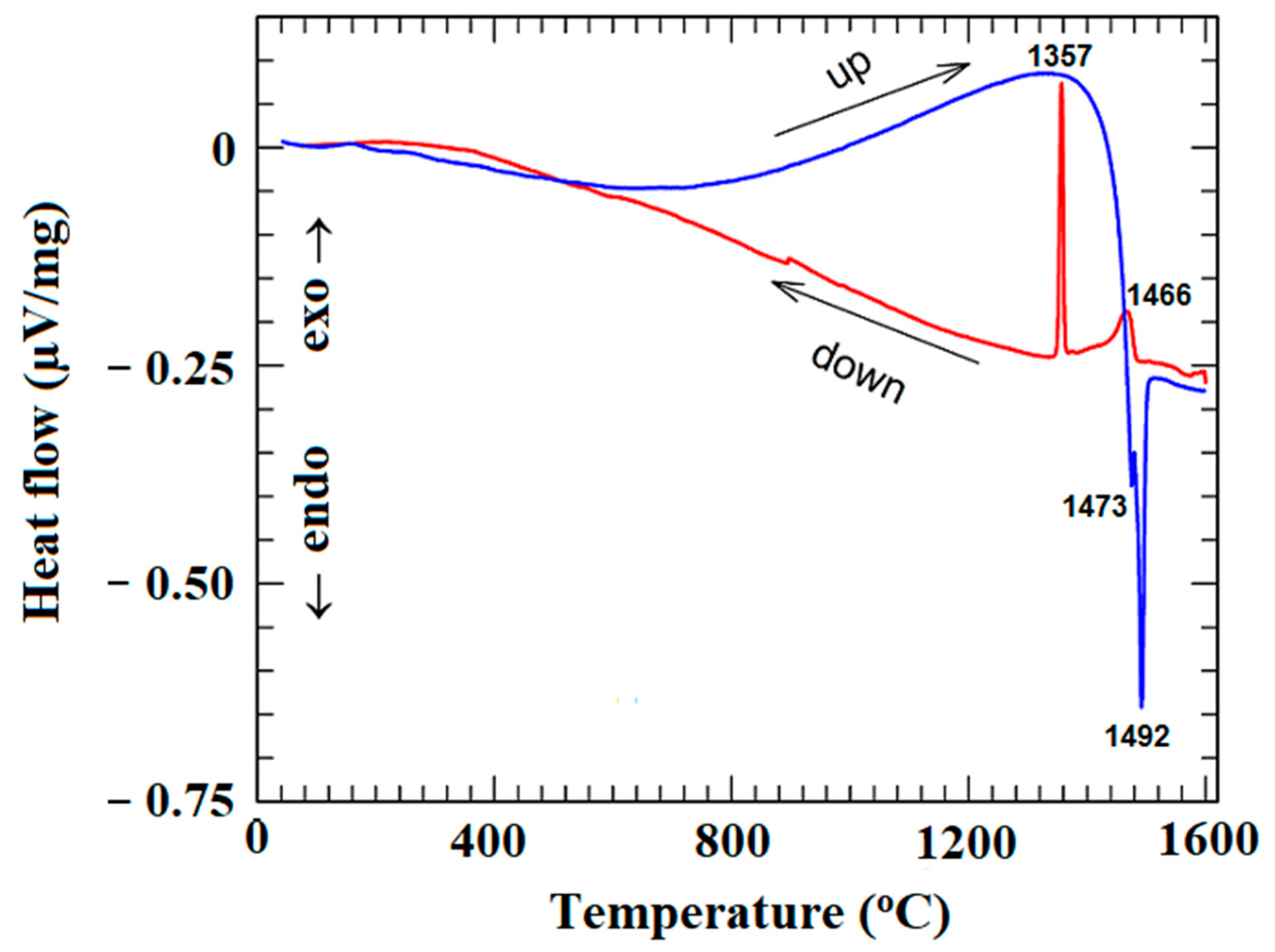

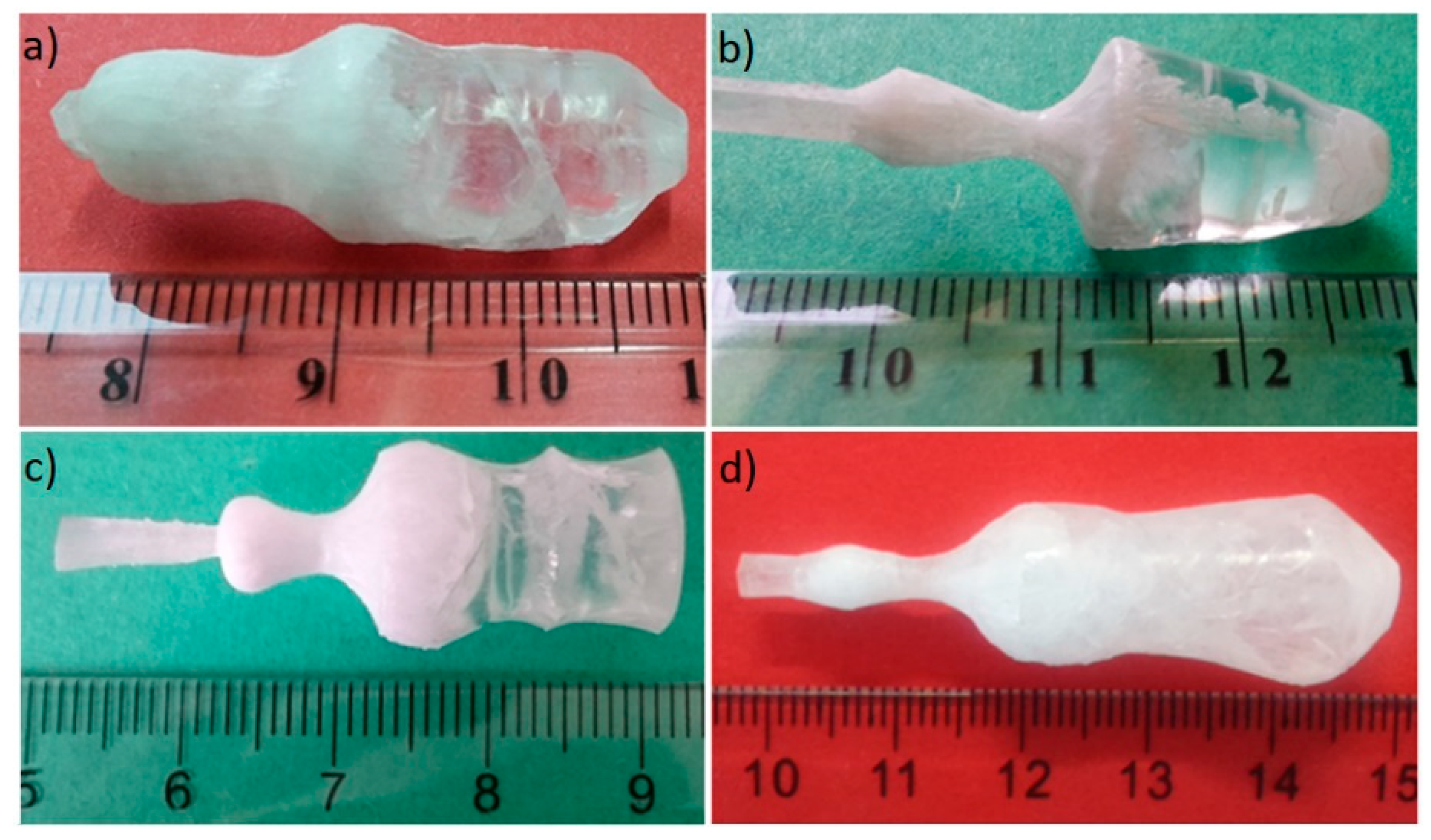
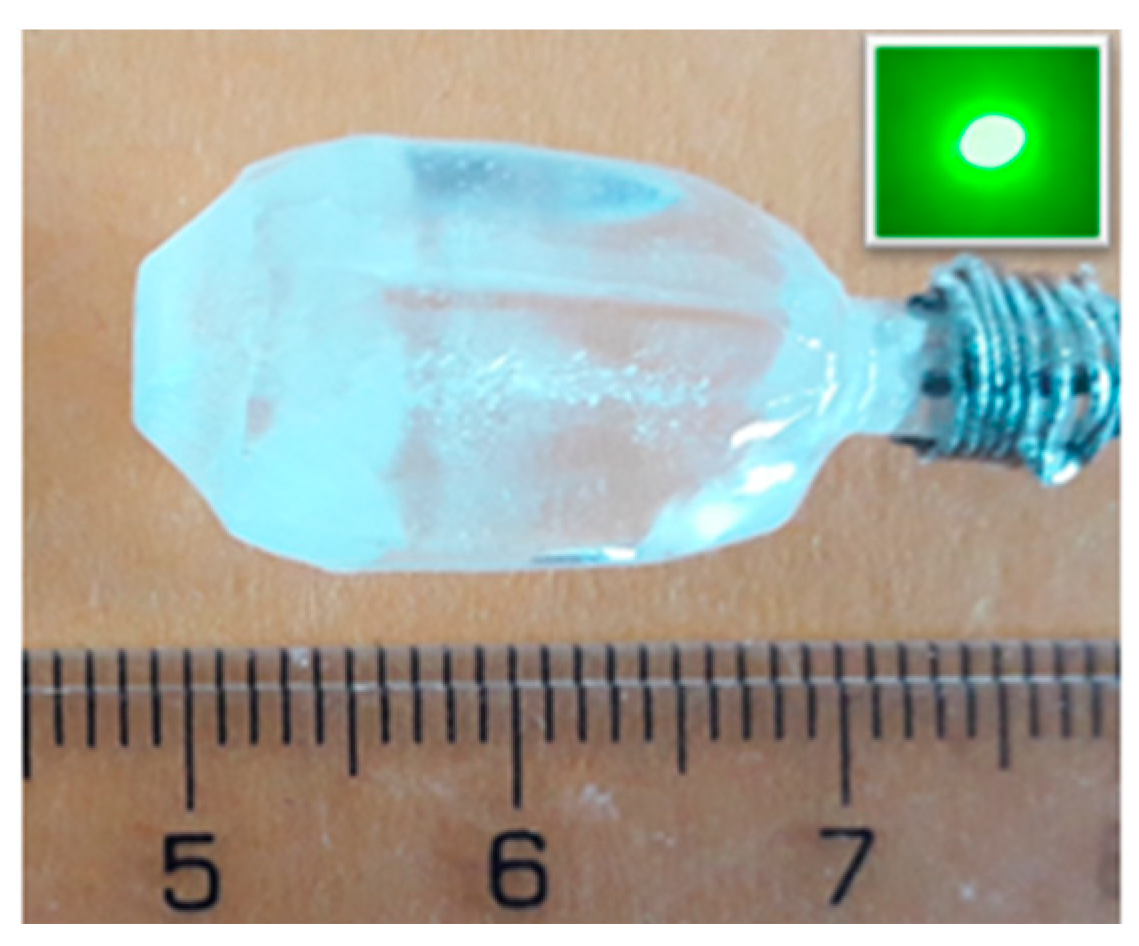





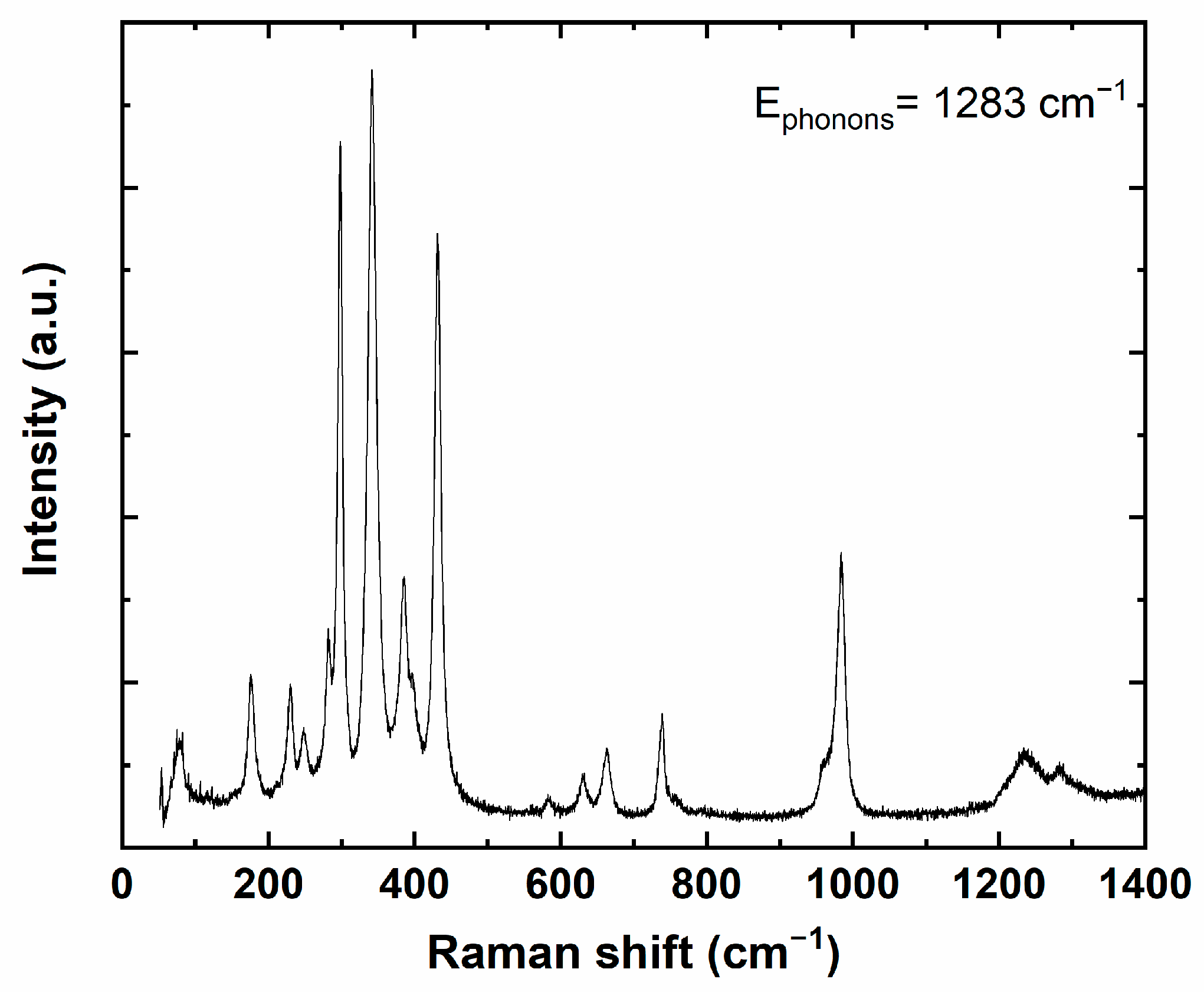






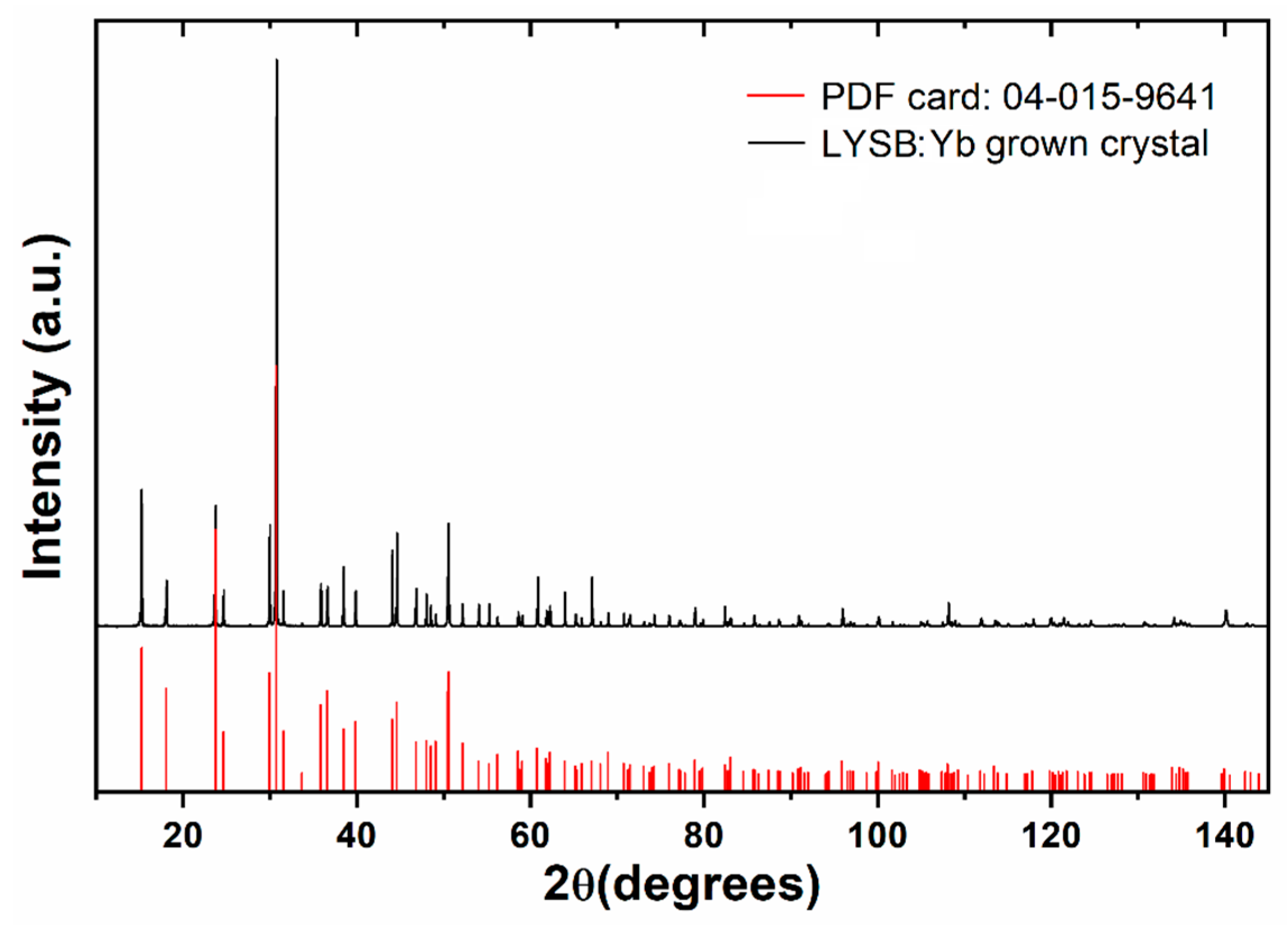


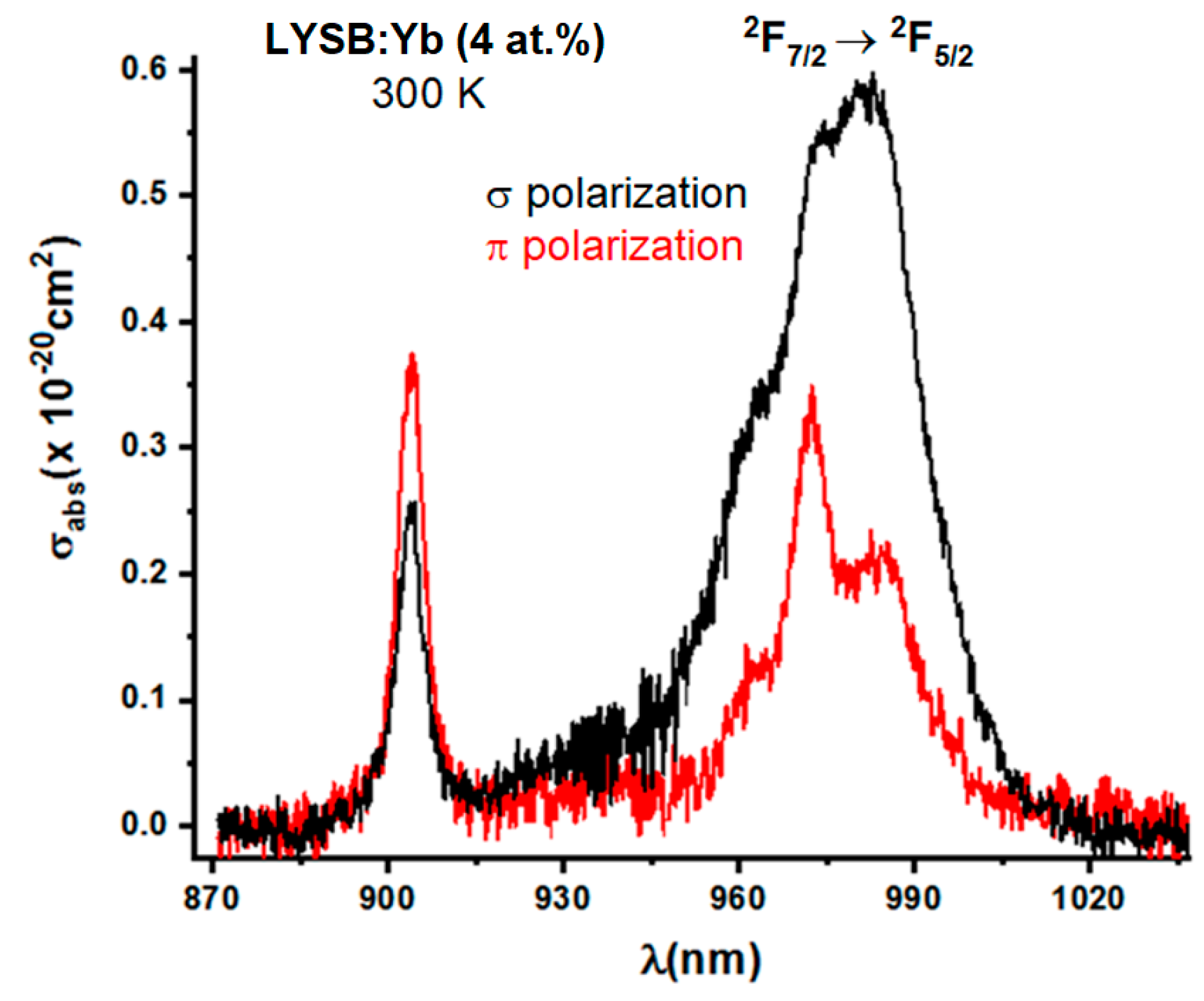
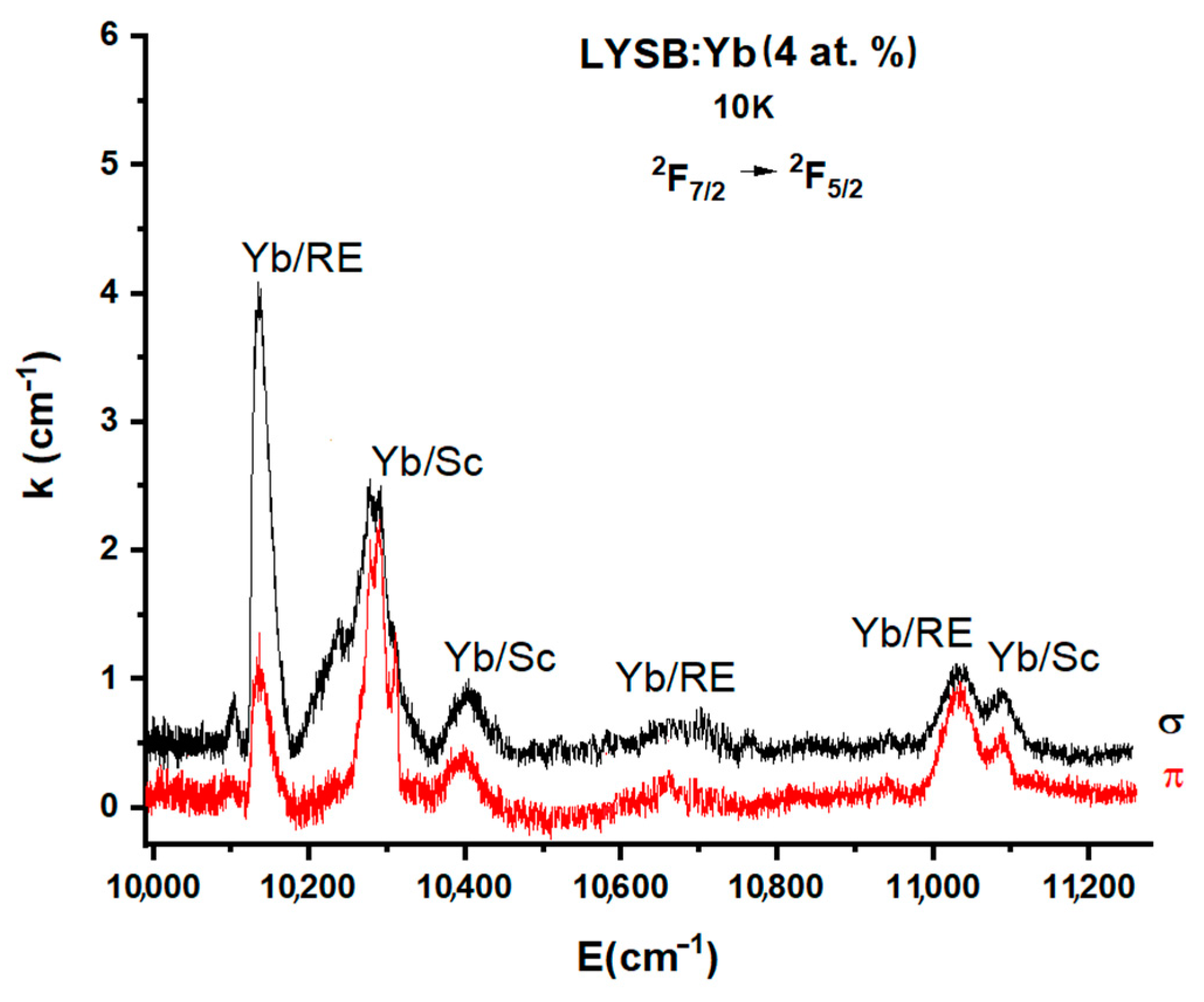
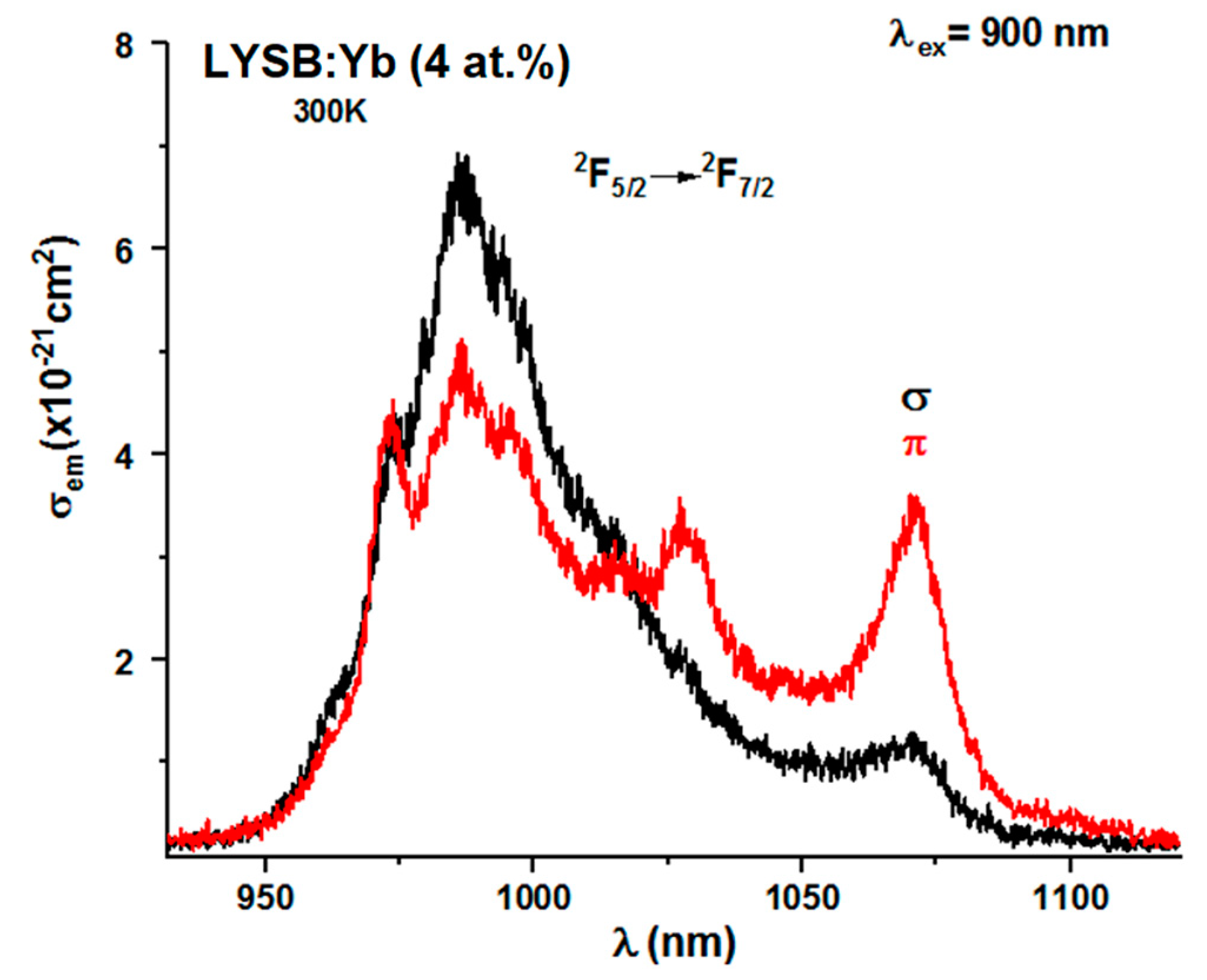
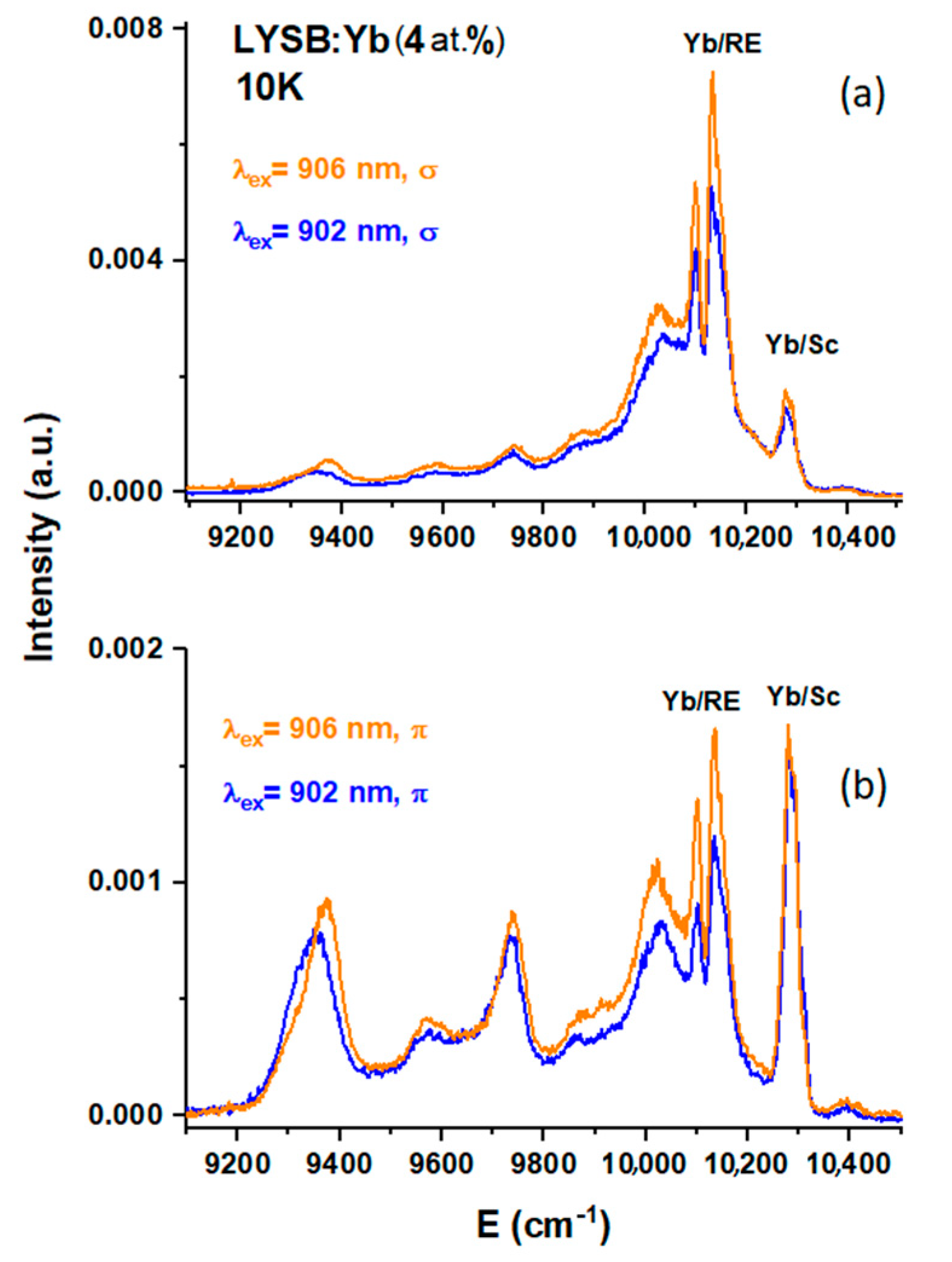
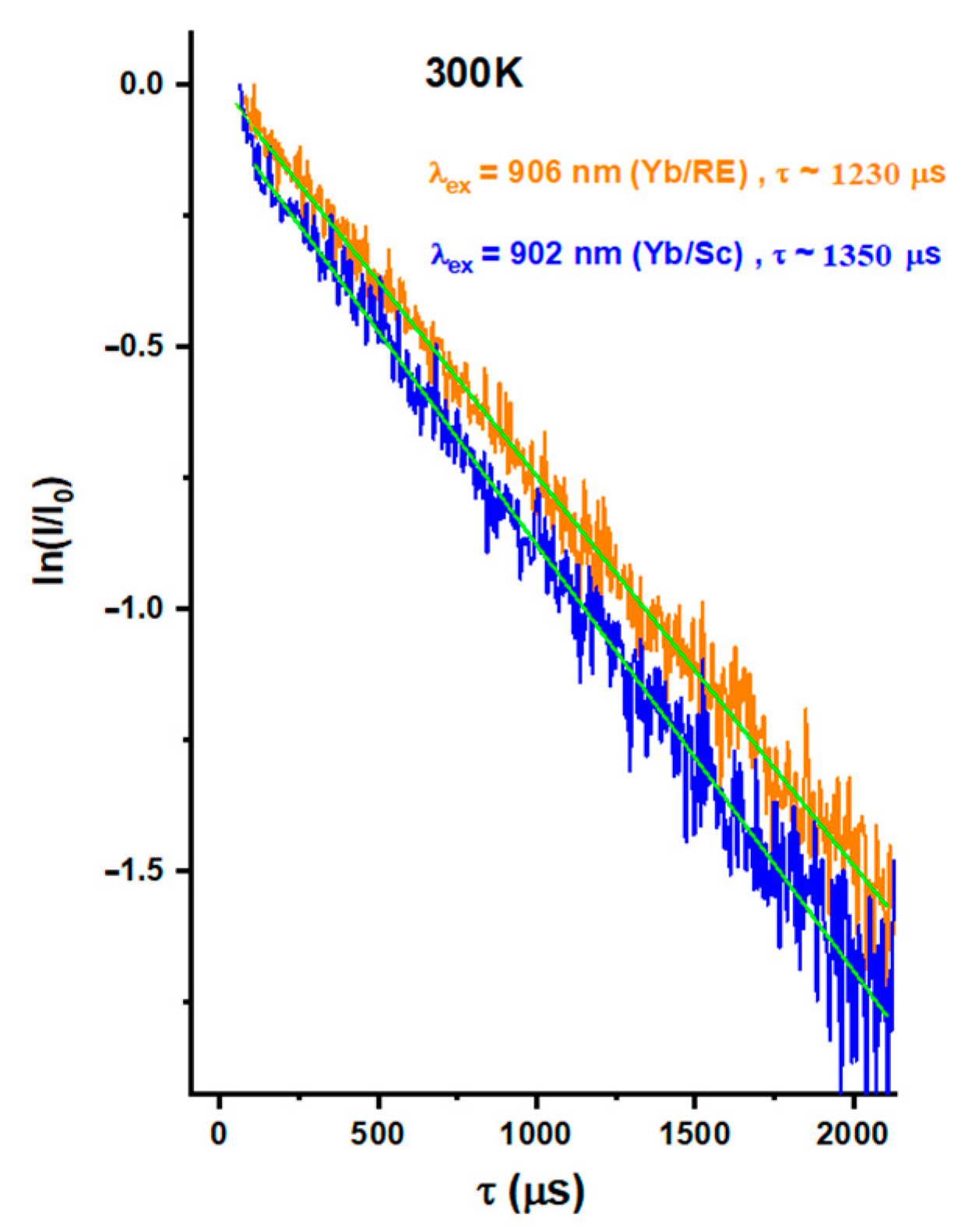
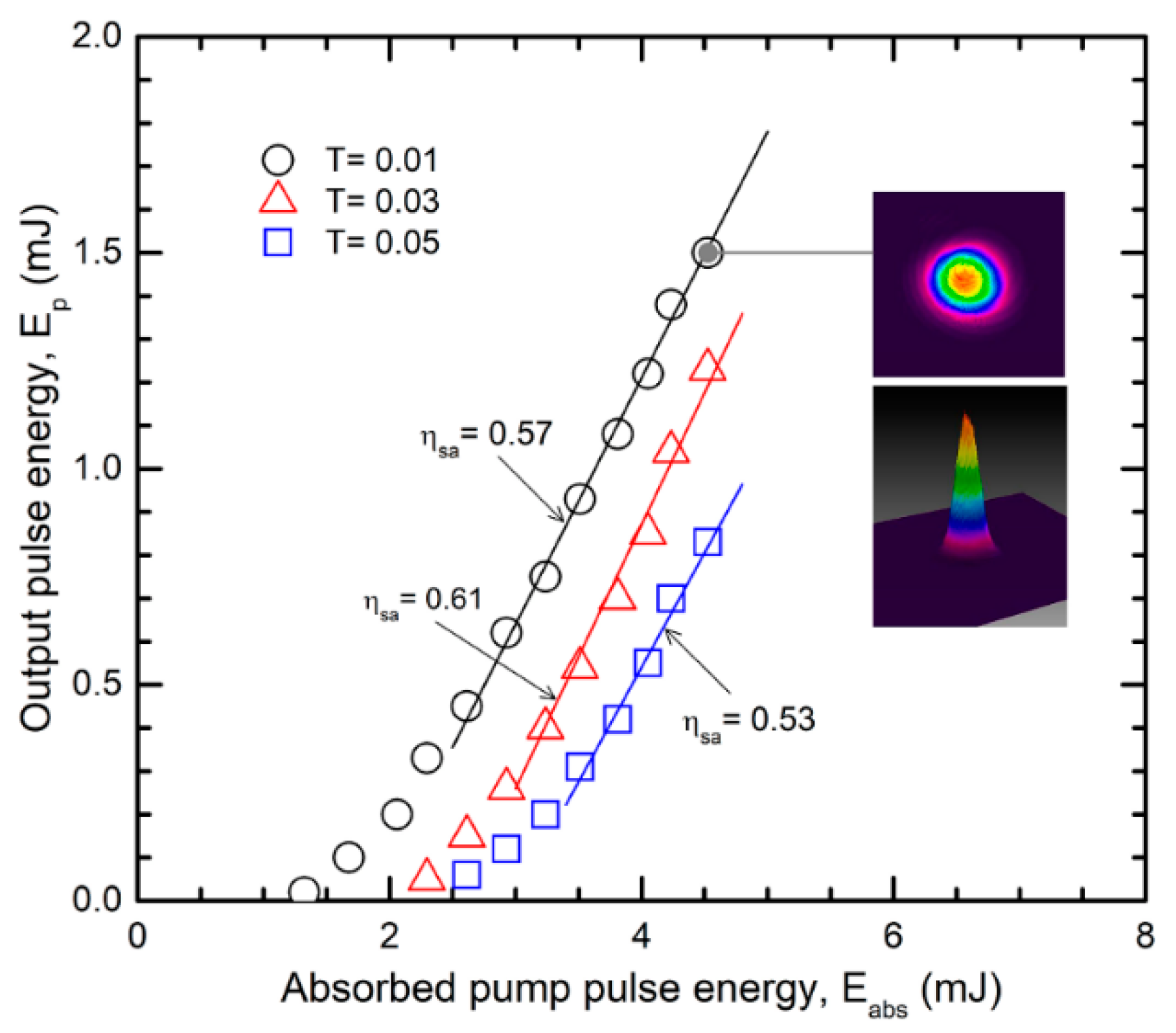
| LYSB Crystal Sample | La/Y Ratio | |
|---|---|---|
| Starting melt | La0.765Y0.485Sc2.75(BO3)4 | 1.57 |
| Shoulder | La0.780Y0.321Sc2.899(BO3)4 | 2.42 |
| Body | La0.783Y0.316Sc2.901(BO3)4 | 2.47 |
| Tail | La0.779Y0.324Sc2.897(BO3)4 | 2.40 |
| Atom | x | y | z | Wyckoff Position | Occupancy |
|---|---|---|---|---|---|
| La | 0 | 0 | 0 | 3a | 0.78 |
| Y1 (La) | 0 | 0 | 0 | 3a | 0.22 |
| Sc | −0.1235 | 0.6666 | 0.6666 | 9d | 0.9667 |
| Y2 (Sc) | −0.1235 | 0.6666 | 0.6666 | 9d | 0.0333 |
| B1 | −0.2317 | 0.6666 | 0.1666 | 9e | 1 |
| B2 | 0 | 0 | 0.5 | 3b | 1 |
| O1 | 0 | −0.4177 | 0.5 | 9e | 1 |
| O2 | −0.0263 | 0.1894 | −0.2009 | 18e | 1 |
| O3 | 0 | −0.1387 | 0.5 | 9e | 1 |
| Wavelength (µm) | no | ne | Δn | |||
|---|---|---|---|---|---|---|
| Measured | Calculated | Measured | Calculated | Measured | Calculated | |
| 0.40466 | 1.8740 | 1.8739 | 1.7847 | 1.7846 | 0.0893 | 0.0893 |
| 0.43584 | 1.8650 | 1.8649 | 1.7773 | 1.7772 | 0.0877 | 0.0877 |
| 0.46782 | 1.8578 | 1.8578 | 1.7714 | 1.7713 | 0.0864 | 0.0865 |
| 0.46801 | 1.8578 | 1.8577 | 1.7714 | 1.7713 | 0.0864 | 0.0864 |
| 0.47222 | 1.8570 | 1.8569 | 1.7707 | 1.7706 | 0.0863 | 0.0863 |
| 0.47999 | 1.8555 | 1.8554 | 1.7695 | 1.7694 | 0.086 | 0.086 |
| 0.48105 | 1.8553 | 1.8552 | 1.7694 | 1.7692 | 0.0859 | 0.086 |
| 0.50858 | 1.8508 | 1.8507 | 1.7656 | 1.7655 | 0.0852 | 0.0852 |
| 0.54607 | 1.8457 | 1.8456 | 1.7614 | 1.7613 | 0.0843 | 0.0843 |
| 0.57906 | 1.8420 | 1.8420 | 1.7584 | 1.7584 | 0.0836 | 0.0836 |
| 0.5893 | 1.8411 | 1.8410 | 1.7576 | 1.7575 | 0.0835 | 0.0835 |
| 0.63623 | 1.8371 | 1.8370 | 1.7544 | 1.7543 | 0.0827 | 0.0827 |
| 0.64385 | 1.8365 | 1.8365 | 1.7539 | 1.7539 | 0.0826 | 0.0826 |
| 0.8082 | 1.8278 | 1.8277 | 1.7472 | 1.7471 | 0.0806 | 0.0806 |
| 0.8773 | 1.8253 | 1.8253 | 1.7455 | 1.7454 | 0.0798 | 0.0799 |
| 0.9745 | 1.8226 | 1.8226 | 1.7437 | 1.7436 | 0.0789 | 0.079 |
| Sellmeier Coefficients | Refractive Index | |
|---|---|---|
| A | 3.30146 | 3.01189 |
| B | 0.03004 | 0.02536 |
| C | 0.02237 | 0.01722 |
| D | 0.0127 | −0.0014 |
| Crystal | (θ, φ) (deg) | Δn @1064 (nm) | ρ (deg) | Δθ × L (deg·cm) | Δλ × L (nm·cm) | |
|---|---|---|---|---|---|---|
| LYSB | (33.4, 60) | 0.078 | 2.41 | 0.034 | 0.60 | 1.35 |
| Crystal | deff (pm/V) | θ Phase-Matching (deg) | Phase-Matching Type | Optical Transparency Window (nm) | LDT * (J/cm2) | Growth Method | Comments |
|---|---|---|---|---|---|---|---|
| LYSB this work | 1.13 | 33.4 | I | 200–2800 | 20 | Czochralski | |
| YAB | 1.45 | 30.8 | I | 170–2800 | 4–6 | Flux | |
| LiB3O5 (LBO) | 1.17 | θ = 90 φ = 0 @150 °C | biaxial | 160–2600 | 25 | Flux | |
| Β-BaB2O4 (BBO) | 2.01 | 22.8 | I | 198–2600 | 13 | Flux | |
| 1.43 | 32.3 | II | |||||
| Li2B4O7 | 0.07 | 30.5 | I | 160–3500 | 40 | Czochralski | soluble in water |
| CsLiB6O10 (CLBO) | 0.49 | 29.2 | I | 170–2600 | 25 | Flux | hygroscopic |
| 0.95 | 42.1 | II | |||||
| KTIOPO4 (KTP) | 3.24 | θ = 90 φ = 22.81 | biaxial | 350–4500 | 15 | Flux | |
| KH2PO4 (KDP) | 0.26 | 42.0 | I | 177–1700 | 10 | Flux | soluble in water |
| 0.34 | 58.6 | II | |||||
| LiNbO3 | not phase-matchable @ 1064 nm | 330–5500 | 14 | Czochralski | |||
| KNbO3 | 10.90 | θ = 90 φ = 90 @188 °C | biaxial | 400–4500 | 1.7 | Czochralski | |
| starting melt | La0.8Y0.4Yb0.05Sc2.75(BO3)4 |
| shoulder | La0.780Y0.320Yb0.040Sc2.860(BO3)4 |
| body | La0.778Y0.322Yb0.042Sc2.858(BO3)4 |
| tail | La0.775Y0.325Yb0.042Sc2.858(BO3)4 |
| Wavelength (µm) | ne | no | ||
|---|---|---|---|---|
| Calculated | Measured | Calculated | Measured | |
| 0.40466 | 1.7852 | 1.7851 | 1.8744 | 1.8744 |
| 0.43584 | 1.7780 | 1.7783 | 1.8658 | 1.8656 |
| 0.46782 | 1.7723 | 1.7725 | 1.8589 | 1.8590 |
| 0.46801 | 1.7723 | 1.7720 | 1.8588 | 1.8589 |
| 0.47222 | 1.7716 | 1.7715 | 1.8580 | 1.8583 |
| 0.47999 | 1.7704 | 1.7701 | 1.8566 | 1.8564 |
| 0.48105 | 1.7703 | 1.7702 | 1.8564 | 1.8565 |
| 0.50858 | 1.7665 | 1.7669 | 1.8519 | 1.8522 |
| 0.54607 | 1.7624 | 1.7626 | 1.8469 | 1.8466 |
| 0.57906 | 1.7594 | 1.7590 | 1.8432 | 1.8429 |
| 0.63623 | 1.7552 | 1.7552 | 1.8381 | 1.8379 |
| 0.64385 | 1.7547 | 1.7548 | 1.8376 | 1.8377 |
| 0.8082 | 1.7472 | 1.7474 | 1.8281 | 1.8284 |
| 0.8773 | 1.7450 | 1.7447 | 1.8253 | 1.8255 |
| 0.9745 | 1.7424 | 1.7424 | 1.8219 | 1.8217 |
| LYSB:Yb 1028 nm → 514 nm | (θ, φ) (deg) | deff (pm/V) | Δλ × L (nm × cm) | Δθ × L (deg × cm) | ρ (deg) |
| (36.0, 60) | 1.09 | 0.74 | 0.031 | 2.53 |
| Polarization | λemission (nm) | ||
|---|---|---|---|
| 986 | 1026 | 1070 | |
| σem (×10−21 cm2) | |||
| π | 5.12 | 3.56 | 3.6 |
| σ | 6.84 | 2.1 | 1.33 |
| Crystal | Manifold | Yb3+/RE3+ | Yb3+/Sc3+ |
|---|---|---|---|
| LYSB:Yb | 2F7/2 | 0, 385, 562, 757 | 0, 250, 547, 950 |
| 2F5/2 | 10,135, 10,659, 11,033 | 10,285, 10,405, 11,085 | |
| LGSB:Yb | 2F7/2 | 0, 394, 545.5, 768.7 | 0, 86.8, 552.3, 927 |
| 2F5/2 | 10,144, 10,678.6, 11,044 | 10,297, 10,412.6, 11,103.4 |
Disclaimer/Publisher’s Note: The statements, opinions and data contained in all publications are solely those of the individual author(s) and contributor(s) and not of MDPI and/or the editor(s). MDPI and/or the editor(s) disclaim responsibility for any injury to people or property resulting from any ideas, methods, instructions or products referred to in the content. |
© 2023 by the authors. Licensee MDPI, Basel, Switzerland. This article is an open access article distributed under the terms and conditions of the Creative Commons Attribution (CC BY) license (https://creativecommons.org/licenses/by/4.0/).
Share and Cite
Broasca, A.; Greculeasa, M.; Voicu, F.; Gheorghe, C.; Gheorghe, L. Pure and Yb-Doped LaxYySc4-x-y(BO3)4 Crystals: A Review of Recent Advances. Crystals 2023, 13, 169. https://doi.org/10.3390/cryst13020169
Broasca A, Greculeasa M, Voicu F, Gheorghe C, Gheorghe L. Pure and Yb-Doped LaxYySc4-x-y(BO3)4 Crystals: A Review of Recent Advances. Crystals. 2023; 13(2):169. https://doi.org/10.3390/cryst13020169
Chicago/Turabian StyleBroasca, Alin, Madalin Greculeasa, Flavius Voicu, Cristina Gheorghe, and Lucian Gheorghe. 2023. "Pure and Yb-Doped LaxYySc4-x-y(BO3)4 Crystals: A Review of Recent Advances" Crystals 13, no. 2: 169. https://doi.org/10.3390/cryst13020169
APA StyleBroasca, A., Greculeasa, M., Voicu, F., Gheorghe, C., & Gheorghe, L. (2023). Pure and Yb-Doped LaxYySc4-x-y(BO3)4 Crystals: A Review of Recent Advances. Crystals, 13(2), 169. https://doi.org/10.3390/cryst13020169








